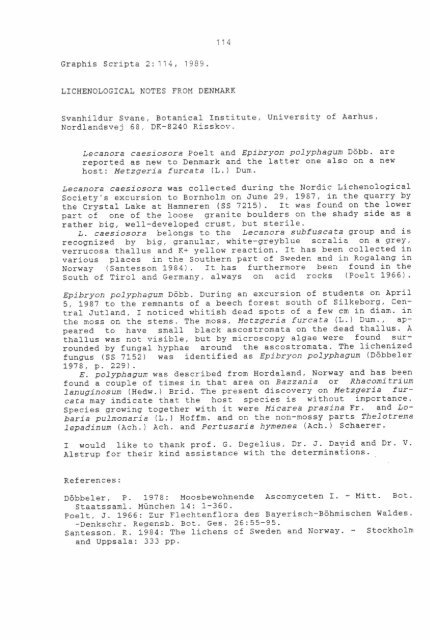Create successful ePaper yourself
Turn your PDF publications into a flip-book with our unique Google optimized e-Paper software.
Graphis Scripta 2:114, 1989.<br />
114<br />
TICHENOLOGICAL NOTES FRoM DENMARK<br />
Svanhildur Svane, Botanical Institute, University of Aarhus,<br />
Nordlandsvej 58, DK-8240 Risskov.<br />
Irecanota caesiosora Poelt and Epibtyon poTyphagum D6bb. are<br />
reported as nen to Denrnark and the latter one also on a new<br />
host2 Metzgteria furcata (L.) Dun.<br />
Lecanora caesiosora was collected during the Nordic Lichenological<br />
Society's excursion to Bornholm on June 29, t987, in the quar<strong>ry</strong> by<br />
the c<strong>ry</strong>"t"I lJake at Hamneren (ss ?215). It was found on the loefer<br />
part oi one of the Loose granite boulders on the shady side as a<br />
rather big, welf-developed crust, but sterile.<br />
L. caesiosora belonqs to the Lecanora subfuscata group and is<br />
recognized by big, granular, white-greybfue soralia on a grey,<br />
verrucosa thallus and K+ yel1oe? reaction. It has been collected in<br />
various places in the Southern part of Sweden and in Rogalang in<br />
Norlray (santesson 1984). It has furthermore been found in the<br />
south of Tirol and Gernany, always on acid rocks (Poelt 1955) '<br />
Epib<strong>ry</strong>on pofyphaqun D6bb. During an excursion of students on April<br />
5, 198? to the rernnants of a beech forest south of silkeborg. central<br />
Jutland, f noticed whitish dead spots of a few cn in dian' in<br />
the moss on the stems. The moss, t'letzgeria furcata (L.) Dun', appeared<br />
to have snall black ascostronata on the dead thallus' A<br />
tnallus was not visible, but by nicroscopy algae were found surrounded<br />
by fungal hyphae around the ascostromata. The lichenized<br />
f,ungus tss zrsz) was identified as Epib<strong>ry</strong>on PoTyphagun {D5bbeler<br />
!978, p. 229).<br />
E. poiyphagun was described frorn Hordaland, Norway and has been<br />
found i coirpf! of times in that area on Bazzania or Rhacomit;".ium<br />
Tanuginosui (Hedw. ) Brid. The present discove<strong>ry</strong> on MetzEeria futc€ta<br />
rnay indicate that the host species is without itTrportance.<br />
species growing together rith it wete Mieatea prasina Fr' and loiaria<br />
pulnonarja (L.) Itoffn. and on the non-rrossy parts TheTotrena<br />
Tepadinun (Ach.) Ach. and Pe<strong>rtu</strong>satia hynenea (Ach.) Schaerer'<br />
I would like to<br />
Alstrup for their<br />
References:<br />
t.hank prof . G. Degelius, D1. . J. David and Dr. V.<br />
kind assistance with the determinations.<br />
D6bbe1er, P. 1978: Moosbewohnende Ascomyeeten I. Mitt- Bot.<br />
Staatssaml. trliinchen t4: 1-350.<br />
poe1t, J. :-956: Zur Flechtenflora des Bayerisch-Bohnischen WaLdes -<br />
-Denkschr. Regensb. Bot - Ges . 25:55-95.<br />
Santesson, R. 1984: The lichens of Sweden and Norway. - Stockholm<br />
and Uppsala: 333 PP.

















